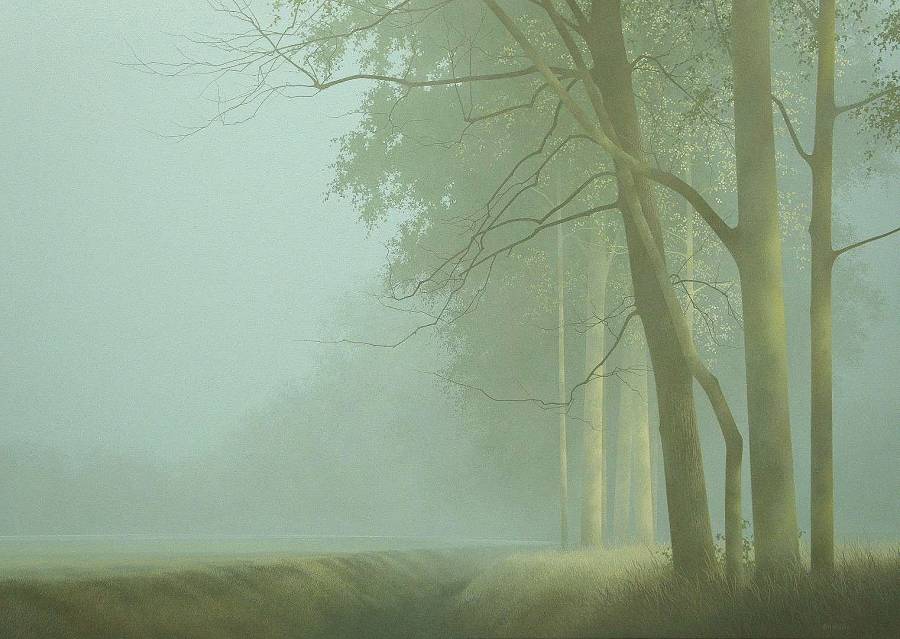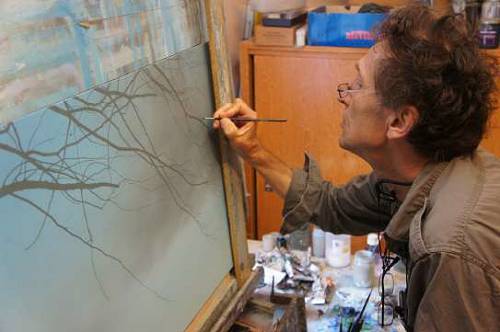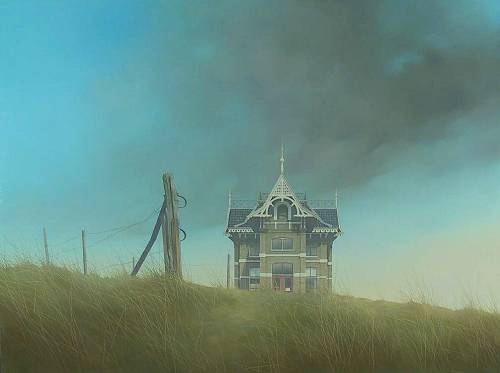“I want the viewer to wonder about its meaning and imagine a personal outcome to the story.”

In your landscapes the real protagonist is the fog. There's always a mysterious and dark atmosphere created by shaded colors. What's the hidden meaning of these atmospheres?
My work is often interpreted as Magical Realism, which is characterized by a sense of pessimism, alienation, melancholy, and uneasiness. Dutch Realism has a long tradition of Magical Realism, beginning in the period between the two World Wars with artists such as Carel Willink, Pyke Koch, and Dick Ket. Although my outlook on the world isn’t as negative as those that the abovementioned artists’ held, the austere atmospheres in my paintings indicate my feelings of unease about how we see (or avoid seeing) this world.
How do you create the scenes of your paintings, they come from your imagination or from reality?
Both, in that I combine elements from multiple photographs until I have an interesting, balanced, but also somewhat unsettling new image.
The choice of subjects is very uncommon: frequently you paint abandoned elements such as wooden stake in the ground or a gate opened on nothing or some Dutch colonial houses. All of these things seem to be "frozen in time", a surreal atmosphere where the flow of time is not compelled. You create a sort of timeless world. What do you think about?
While the ideas and subject matter come from reality, I try to create a new and isolated reality which doesn’t really exist or sometimes only occurs for a short moment in time. Besides capturing a silent moment of respite in a turbulent world, I want that seemingly peaceful landscape to convey a vague sense of discomfort. I want the viewer to wonder about its meaning and imagine a personal outcome to the story.
Most of your paintings represent natural landscapes without human presence. We think that everyone, seeing them, could feel the silence and the sense of isolation transmitting. What is your relationship with nature?
Sometimes I am afraid that we have lost the sense of being part of nature, that we no longer have an eye for its beauty and healing power. In this hectic world where there’s almost no time for contemplation, I hope my paintings add to a sense of connection with the mysterious magnificence and restorative serenity of nature.


Sfumato is the technique of over lapping and blending several layers of transparent paint in order to soften tones and blur outlines. This method helps me create a fine haze that builds up an atmospheric perspective and adds mystery.
You come from Netherlands, where, it's known, there's a long artistic tradition. Is there a painter from the past that inspires you? And how did you know and get passionate about hyperrealism?
I’m highly inspired by the work of the German painter Caspar David Friedrich, whose paintings have a glorious and exalted quality that seems quite mystical and unearthly to me. I studied at the art academy in Groningen which taught realism in the traditional method until the 1970s. I feel fortunate to have been coached by charismatic teachers
such as Matthijs Röling and Wout Muller, who had a great and lasting influence on my work. During my time at the academy, there was a large exhibition in the Groningen Museum of Hyperrealists and Photorealists which had great impact on me. Despite being attracted to this art style, I’ve always wanted to be free from strictly photographic subject matter to manipulate environments and atmospheres in order to create my own visual world.
Your art has been exposed in many parts of the world and in many international contexts. What is the most growing experience that you remember with pleasure?
One day, I was contacted by Frank Bernarducci, inviting me to participate in a group exhibition in the context of Bernarducci Meisel Gallery First Look together with many wonderful artists such as David Eichenberg, Robin Eley, and Adam Normadin. This tur ned out to be an important steppingstone into connecting with another US gallery, CK Contemporary in San Francisco, where I’m proud to be part of their talented stable of artists.
What are your aims and projects for the next future? Tell something about it.
It’s difficult to say, I want my art career to evolve naturally and I prefer to follow my intuition in regards to art opportunities. My most important goal is to continue to surprise and delight people in The Netherlands and abroad with new, dreamy, mildly critical, and thought-provoking paintings.
 NL
NL EN
EN DE
DE
